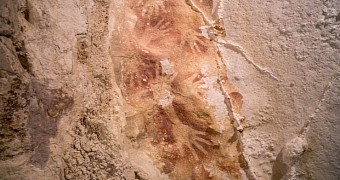In a paper published in yesterday's issue of the journal Nature, researchers argue that a collection of paintings discovered in a limestone cave in Indonesia back in the 1950s constitutes the oldest evidence of artistic creativity thus far documented.
Otherwise put, evidence at hand indicates that these paintings that scientists came across on the island of Sulawesi in Indonesia represent the oldest cave art to have until now been found and studied.
Thus, archaeologist Alistair Pike with the University of Southampton in the UK and fellow researchers argue that these images were created quite a while before the art documented in caves scattered across Europe.
The millennia-old paintings
In their paper in the journal Nature, archaeologist Alistair Pike and colleagues detail that, at the time they were discovered in the 1950s, the paintings were assumed to be just 10,000 years old.
The rationale behind this announcement that the newly found images had to have been created about 10,000 years ago was pretty simple and straightforward (and as it turns out, erroneous): no way anything older than this would've have been in such good condition.
To determine the real age of the paintings, researchers analyzed the makeup of the calcium carbonate coating them. The focus was on determining how much uranium and thorium were present in the mineral layers covering the images.
Mineral layers tend to draw in uranium when deposited. In time, the uranium decays into thorium at a steady and well documented rate. By studying the thorium and uranium content of the calcium carbonate, scientists were able to determine the age of the paintings that were coated by it.
As detailed by Nature, the oldest of the 12 stencils of human hands analyzed as part of this investigation was found to have been created at least 39,900 years ago. This makes it 2,000 years older than the earliest European hand stencil.
The image of a babirusa, i.e. a pig-like animal, was shown to have been created at least 35,400 years ago, which is about the same time that Europe got its first art cave showing large animals that our ancestors shared their world with.
The importance of this find
Archaeologist Alistair Pike and fellow researchers say that the discovery of these paintings indicates that symbolic painting originated independently but somehow around the same time in opposite sides of the world.
“It allows us to move away from the view that Europe was special. There was some idea that early Europeans were more aware of themselves and their surroundings. Now we can say that’s not true,” specialist Maxime Aubert, an archaeologist at Griffith University in Queensland, Australia, said in a statement.
Then again, it could be that this form of art was born in Africa and then spread to other continents. If this second explanation is the right one, archaeologists expect that they will find evidence to back it up while exploring the migratory route of our ancestors.

 14 DAY TRIAL //
14 DAY TRIAL //